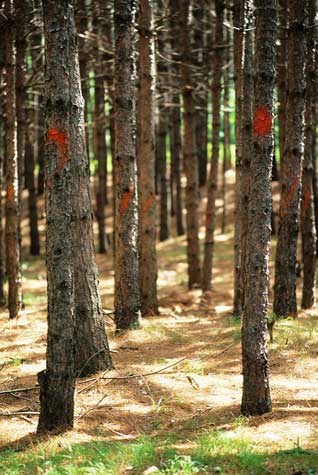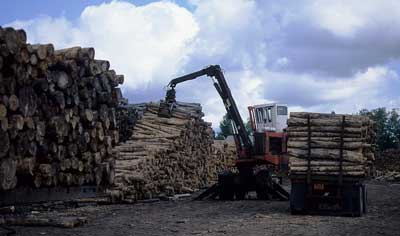Our monthly eNewsletter Woodland News You Can Use covers the topics that matter most to you as a landowner: Wildlife, Invasive Species, Taxes, Cost-Sharing Programs… and More!
How much are my trees worth?
By John Duplissis, Rural Forestry Program Leader, Nebraska Forest Service
How much are my trees worth? I suspect every forester has heard this question at some point in their career, and we all, unfailingly, give the world’s most unsatisfactory answer: Work with your forester and get multiple bids.

We won’t use your email address for any other purpose and you may unsubscribe at any time.
*Required field
Photo courtesy of WI Department of Natural Resources
A professional forester will be knowledgeable about local markets, what the mills are buying, and at what times of year mills may be paying more for certain grades or sizes.
But it also helps to know how much a tree is worth. The short answer is that the value of a tree is defined by the types of products you can manufacture from it and who is interested in buying your trees from you.
The longer answer is that the monetary value of a tree is determined by four factors: the volume of the tree, the grade of the butt log, the potential products it can be turned into, and the current markets for the species.
Markets and products
Let’s start with the tree itself and the kinds of products it can be turned into. Most people are familiar with pulp and sawtimber, but many more markets exist for trees than just these two.
Potential markets for red pine, for example, include biomass, pulp, sawtimber, utility poles, and log cabin logs. These are relatively well known markets, and mills may need certain species and sizes for specialty products, depending on your location.
As a general rule of thumb, the larger a tree grows the more it’s worth, but there are exceptions. Red pine trees that can be manufactured into utility poles may be more valuable than those large enough for sawtimber or log cabin logs.
Also, it’s likely that a given tree can yield more than one product. A tree large enough to yield a sawtimber-sized butt log will usually have “topwood,” as well. “Topwood” is best described as the pulp sticks that can be harvested from the main stem or branches, which are large enough to be sold as pulp but not large enough for other products.
Additionally, topwood that is too small for pulp may be sold for biomass. So, it’s possible, even likely, to manufacture more than one type of product from any given tree. In other words, the value of a tree is based on all the products that might be gained from it.

Photo courtesy of WI DNR
Tree species
Perhaps the most important factor to consider is the species of a tree. The properties of wood differ from tree to tree; the density, grain, and figure make each species unique. Also, wood is a commodity and bought and sold as a commodity. This means that wood that is scarce often demands a very high price and wood that is common can be bought and sold relatively cheaply.
Aspen, for example, is a fast-growing, short-lived tree. Its wood is described as white sapwood blending into light-brown heartwood; the contrast between the sap and heartwood is small. The wood also has a fine, uniform texture and is straight-grained.
Aspen is often harvested for pulp and is one of the least expensive woods on the market because it has very little use beyond pulp.
Sugar maple, on the other hand, is a slower growing and longer-lived tree. The wood of sugar maple is described as creamy white sapwood with a slight reddish brown tinge, with heartwood that varies from light- to dark-reddish brown. Both sapwood and heartwood can contain pith fleck. The wood has a close, fine texture and is generally straight-grained, but can also occur as “curly,” “fiddleback,” and “birds-eye” figures.
Sugar maple is one of the more expensive woods on the market because of its grain and figure, but also because it can take a lifetime to grow into sawtimber-sized material. There are not nearly as many acres of sawtimber-sized sugar maple available as there are acres of pulpwood-sized aspen.

Tree volume
Scale is the measure, or volume, of merchantable wood in a tree. The volume of a log is a function of its diameter and its height or length. The scaling diameter is defined as the diameter (inside the bark) at the small (or top) end of a stick or log. That’s because this defines the largest “cant” that can be sawn from the log.
Photo courtesy of WI DNR
In other words, the number of boards that can be sawn from a round log depends on its small end, not the large, because the log will be sawn into a rectangular cant.
Most folks have heard the term “board foot,” which is the volume of cant that can be sawn from a log. “Cord,” in contrast, is a measure of the stacked wood cut from a log, including the bark and air spaces between the stacked pieces.
A log’s volume is also determined by its length. Pulp is most often measured in 8-foot- or 100-inch-long “sticks,” whereas sawbolts are usually eight feet-long plus trim. Sawlogs are usually 16 feet-long but can vary, with certain shorter lengths depending on the diameter of the log.
Grade
Last but not least is grade: a measure of the value of a tree. Specifically, grade is used to describe the quality of a “butt log” in a sawlog-sized tree. It’s determined by estimating the amount of clear wood (defect-free stem length) within the butt-log, the butt log being the first log cut above the stump.
The two factors that affect grade are the diameter of the butt log and defect. (Pulp-sized trees do not have a grade since they are too small for sawlogs.) Sawlogs usually fall into four categories: grade 3 logs must be at least 10 inches in diameter at breast height (DBH); grade 2 logs must be at least 13 inches DBH; grade 1 logs are at least 16 inches DBH; and veneer needs to be at least 22 inches DBH.
However, these are the minimum requirements: The number of clear cuttings, or length of the log free from defect, is another important factor. A defect is anything that would lead you to believe that the wood underneath the bark is not in perfect condition. Defects can include knots, epicormic branching, decay, fractures, and crook and sweep.
Sign up for our FREE eNewsletter!
Want more great resources sent directly to your inbox? Our monthly eNewsletter covers the topics that matter most to you as a landowner: Wildlife, Invasive Species, Taxes, Cost-Sharing Programs... and More!





